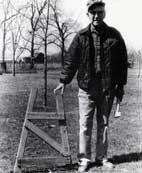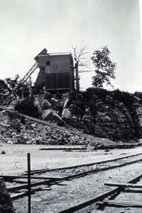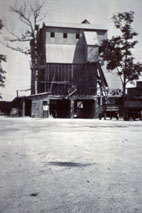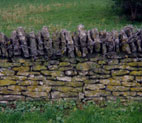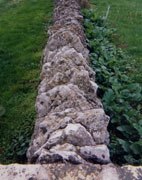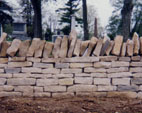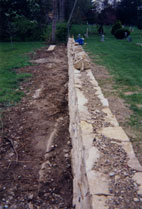


The Limestone Art: Eli Pinney, a fourth generation stonemason explains the trade his father passed to him
By Shauna Valentine and Tracey Bauer
While driving through the village of Dublin, one cannot help but notice the stonework. The natural supply of limestone in this area has provided a readily-abundant material for building such area structures as the Dublin Bridge, stone houses, cemetery posts and the stone fences.
Eli Pinney, a fourth generation stonemason, and his father, Frank (Hop), built some of the finest stone fences and homes we see standing today. Other area stonemasons were: Dan Eger, Ticky Wing, Rufus Snouffer, Jim Rumsy, Harold and Early Pinney, Bill Sheppard and Bill Lamb.
Today stone fences are mostly used for decorating yards or property boundaries, but years ago farmers used them to fence in livestock. “Farmers used to use them for fences for their cattle. They’d build them about somewhere between 42 and 48 inches high,” Pinney said.
Some of Dublin’s stone fences are as old as the town itself. “The oldest stone fence in Dublin is down along the river. It’s under water now,” Pinney said. “The road (Riverside Drive) used to go down (by the river) instead of up and you’d go down there fishing and you’ll hit it once in a while. It’s 30 feet from the bank across from where the old Snouffer quarry used to be.”
Building a stone fence is an art in itself. Eli Pinney believes the form originated in Germany. The stone was acquired from area quarries or from basements of newly built Dublin homes.
“Artz’s quarry north of town was where my dad and I got a lot of stone,” Pinney said. “You take bars and pry and pull up and put a rock underneath and hit it with your sledge. Some rocks come out as big as a room. You clean them off. We used to have a big iron ball and it had two handlebars on its sides. Your bring it over your head and bang it down on there and break the rock. It weighs 60 pounds or better, big as a bowling ball. You didn’t want to stagger much with it!
“In the winter when we couldn’t work building, we’d go to the stone quarry and dress out stone. You had a stool and you just sat there and pecked all day long! You can dress out about a ton, ton and a half maybe a day.”
Stone is dressed by hitting the outside edges with a five pound hammer until the correct shape is reached.
When it came to building the fences, wooden forms or “racks” were used as a guide to lay the stone. The masons built by rods, a term of measurement meaning 16 and a half feet long and four tons of stone.
“We have a rack that we make,” Pinney said. “all the stones are tilted in towards the middle. It starts out (on the bottom) at 24 and winds up (on top) at 14 inches. All the stone are proportioned together. You don’t dig down for a foundation, you pick out your biggest stone and lay them all down. Then put your rack on and leave three inches and step over and put your rack three inches in. If you dig down a foot for a foundation, the water would run under it and it would settle. So we just lay all of our big stone down on the bottom for a footer.
“Most of these stone fences, the way they were built, somebody dug their basement there in Dublin and took the stone from that and went out and put it on the fence. When my dad was a young fella, he had a team and he would lay a rod of stone fence, furnish the stone for $2 a rod (one man can lay between a rod and a rod and a half a day). Now today if you had to buy the stone and everything, four ton to a rod, it would cost $70 a ton and then your labor is high. My dad worked for a dollar a day then. The stone was given to him, they’d just take them out of the quarries.”
Stone working has been in the Pinney family for many years. Mr. Leppert taught Eli’s father and the trade was passed, somewhat reluctantly to Eli. Eli is currently instructing his son David in the art.
Eli recalls how he finally convinced his father to let him learn the trade back in the depression (sic) years:
“My dad never wanted me to be a stone mason. When they built the Dublin bridge (1935) he was foreman. He wouldn’t give me a job. I was laying stone around town in different places then. I was just picking it up myself ‘cause he wouldn’t let me do anything. He wouldn’t even pay any attention when I started talking about it. He said, ‘It’s too hard a work. You don’t want to learn this trade.’ I finally went over to the bridge job and asked Clark Coffman who was overseer of hiring, I guess you’d say and I said, “Clark, I want a job layin’ stone.” And he said, “Well, can you lay underground?’ And I said, ‘Yeah.” I started anyway and was laying underground for about four days and the inspector came and said, ‘Say young fella, you’re doin’ a better job than these fellas who’s a layin’ up on top.’ So he moved me up on top. Then my dad comes down with a big wheel barrow of stone and he said, ‘Here’s bunch of corners for ya.’ He finally gave in.”
Today Eli and his son Dave still build stone fences, posts, stone homes and stone birdbaths. The birdbaths are made in a form with mortar binding the chips of granite together. Most of the granite chips are left overs from their fireplace jobs.
Mortar was not used in the earlier years, but now Pinney uses some on the top layer to give the modern fence more strength. Pinney and his son are kept busy repairing sections of fence hit by cars as well as custom building customer’s (sic) projects.
Shauna Valentine and Tracy Bauer were seniors in the Dublin High School Composition Class under teacher Joyce Hotchkiss. This article was one of several articles printed in the Spring, 1984 edition of “Shanachie, a magazine of Dublin culture and history”, published by the class.
